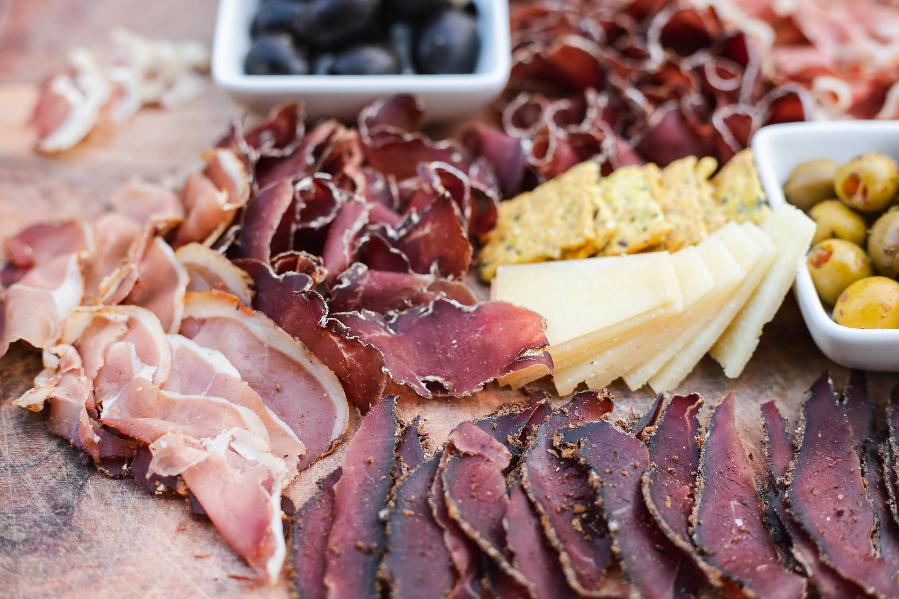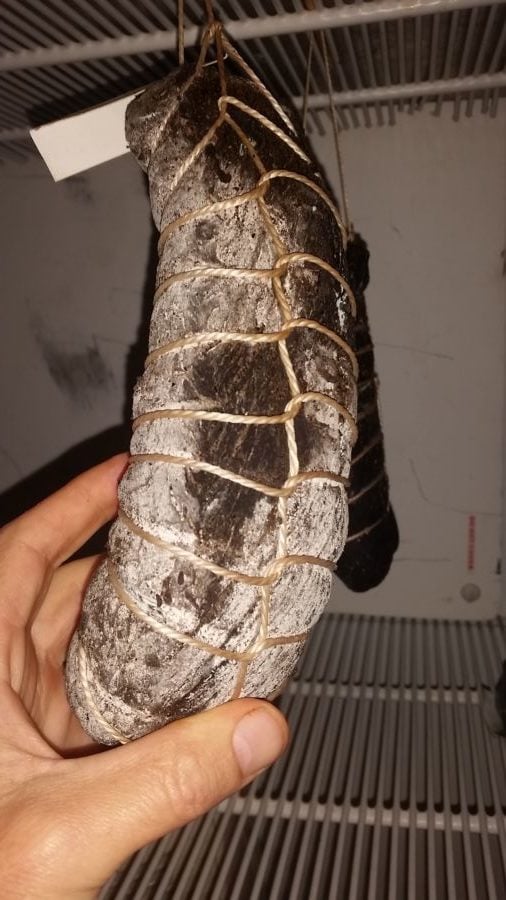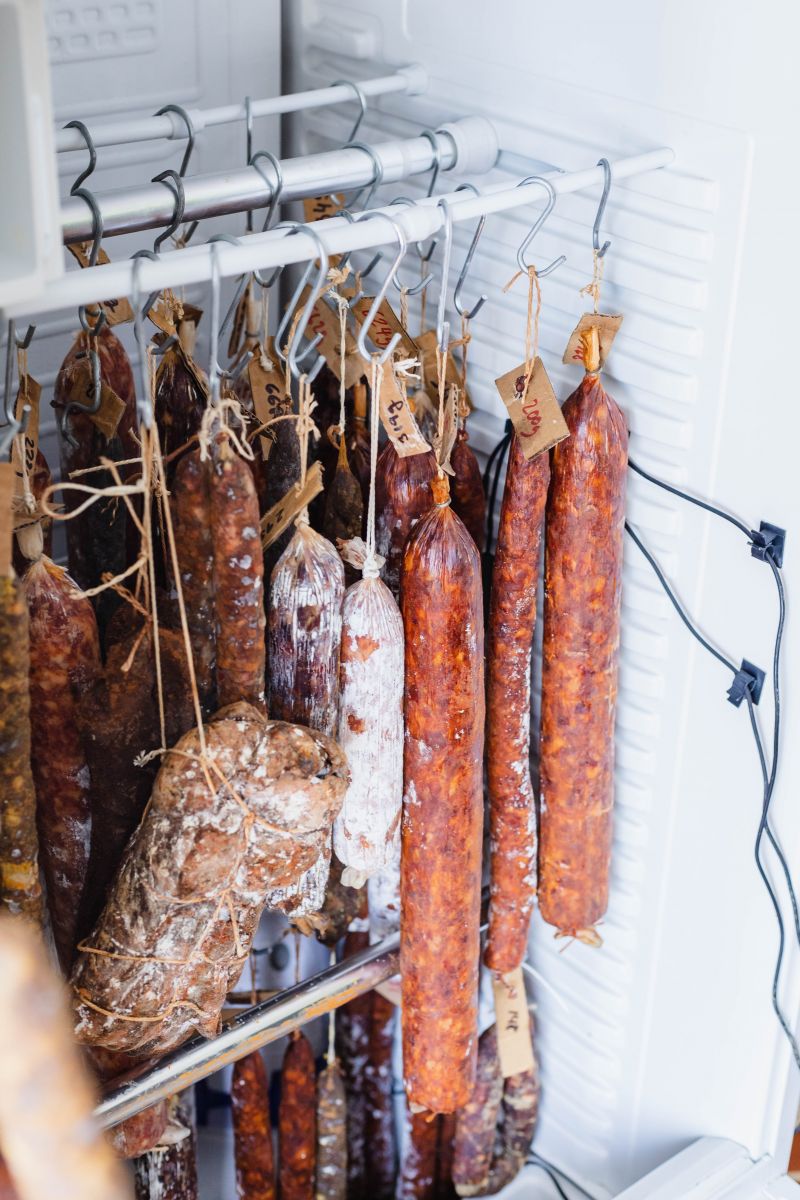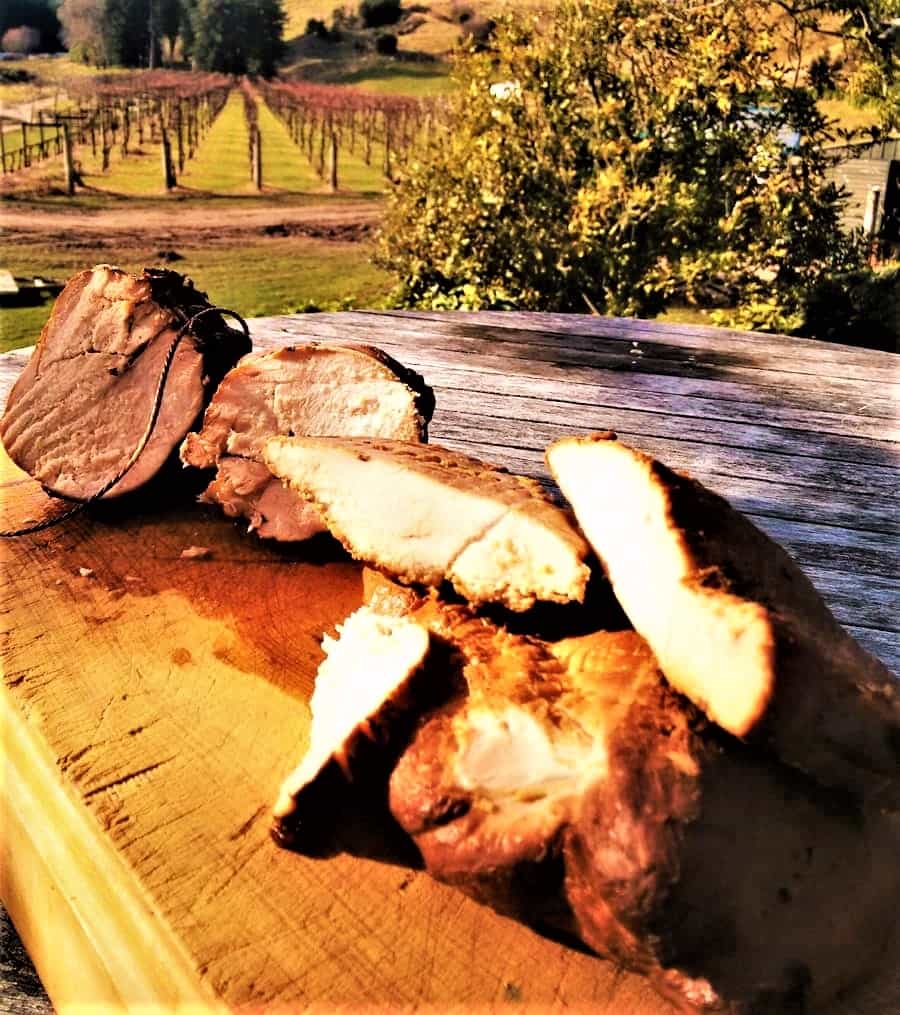The meaning of cured meat seems simple, but I want to discuss it in more detail due to its variations and different types.
For instance, some cured meats, like dry-cured meats, are ready-to-eat, like prosciutto or dry-cured picante salami.
Then, on the other hand, you have dry-cured cold smoked bacon, one of my cured meats I make regularly. This is cured meat, but it is cold-smoked and dried. It’s cooked only before it’s eaten, I’ll go over all this below.
Let’s talk about all the variations of smoked ham cooked and smoked simultaneously. Yes, we are just scratching the surface. Xmas Ham, Ham Hock, Pressed Ham, Deli Ham, etc.
I’ll categorize the different approaches. I’ll cover the main variations of cured meat as well.

First, a simple answer. Then, I will continue with the other information below.
Curing meat means using salt to inhibit or hold moisture on the meat. Curing meat can be done for preservation and flavor or only for flavor and no preservation.
For cured meats like pastrami, the cure is a wet brine of spices, water, and salt with some acidity, like vinegar or other variations. Then, you smoke and cook it to a safe temperature to eat (this is often called hot smoking).
Pastrami is not long-term preserved meat; the wet brine gives it slightly longer before spoilage, longer if vacuum packed. However, it is not preserved like other forms of dry-cured meat. For dry-cured, salt is applied first and carefully dried until bacterial growth is minimized.
Salt also holds moisture by using the process of water binding. This is one of the reasons why a wet brining solution keeps a Christmas turkey moist (it’s cured but for no preservative effect). This type of salt wet curing involves holding moisture on the surface to prevent the drying out of the meat during cooking.
It all comes down to the level of salt solution in the brine and how long it’s in the brine. The more modern technique of equilibrium brining means you work out a percentage of salt to the weight plus the amount of water.
To be more precise in brining, check out a meat curing and brining guide on this site.
On the other end of the spectrum of cured meat is dry-cured Prosciutto Parma ham, which takes 1 month of salt curing and 11 months minimum to ferment, dry, and age. Using 3 of the curing functions, I’ll cover below more.
How Does Meat Cure?
Primarily, meat is cured using salt. The salt plays two roles:
- Water Binding
- Diffusion
Water Binding
Water binding means the salt in the water is binding to the meat muscle cells. In other words, it ‘has ‘clinging’ and inhibits the meat.
Unwanted Bacteria do not like salty, acidic, smoky, or cold (link to preserving meat I wrote) environments.
This salt inhibition is used to deter unwanted bacteria or slow growth.
Salt is also used to hold in moisture whilst cooking. When meat is cooked and smoked simultaneously, such as smoked ham. The water binding to the salt is beneficial.
Salt is the primary ingredient in cured meat. However, there are other ingredients and processes.
Diffusion
Salt curing relies on a simple but powerful process called diffusion.
When salt is applied to meat—whether dry or a water-based wet brine/cure
There’s a naturally occurring movement of molecules from a region of higher concentration (the salty exterior) to a lower concentration (the meat’s interior).
Because the salt concentration is greater on the outside, salt will continue to move inward until it’s more or less evenly distributed throughout the piece of meat.
This gradual movement is driven by osmotic pressure, the tendency of water to flow toward areas of high solute (salt) concentration to balance concentrations on both sides of a permeable membrane (such as cell membranes in meat).
As salt molecules travel into the meat, they draw out water from the muscle cells, lowering the overall moisture level.
That’s the key to the process.
This reduction in moisture—inhibits the growth of spoilage microorganisms.
With less water available, bacteria have more difficulty surviving or reproducing. Thus, diffusion imparts flavor throughout the meat and acts as a preservation method, making salt curing one of the oldest and most reliable ways to keep meat safe.
Methods of Curing Meat
The main ways to cure meat are:
- Dry Cured or Air Cured Meat (With or Without Cold Smoking)
- Cured With a Wet Brine, then Drying
- Wet Cured Brine and Cooked/Hot Smoked
Examples
| Dry Cured | Wet Brined / Cold Smoked | Wet Brine / Hot Smoked |
| Pancetta | Kippers | Patrami |
| Prosciutto | Smoked Herrings | Smoked Ham |
| Braesola | Cold Smoked Salmon | Deli Ham |
| Dry Cured Salami |
Ingredients, Variations & Processes
- Salt
- Spices
- Vinegar
- Mold Culture
- Nitrates/Nitrites (Pink Curing Salt)
- Cold Smoking
- Hot Smoking / Cooking
Salt
This is the main curing ingredient – salt is used in a dry or wet cure, as mentioned.
There are also different ways for dry curing; they are all aimed toward the same outcome:
- Air Curing
- Salt Curing
- Salt Box Curing
- Saturation Curing
- Equilibrium Curing
For using a cure that has salt & water, other names are:
- Wet Brining
- Pickling
- Wet Curing
Spices
I’ve discovered over the years that properties are associated with different spices.
Coarsely ground peppercorns have been used traditionally to cover dry-cured meats for thousands of years.
Pepper has antibacterial and antifungal properties. So, as you can imagine, it somewhat protects the surface and the inside of the meat.
Hard and soft green herbs have different properties.
As well as other traditional herbs like fennel and cumin.
Different studies have concluded that the use of thyme increases stability and reduces lipid oxidation during the shelf-life period of foods (meat, meat products, milk, fish or fish products), which makes thyme a promising source of natural additives
https://www.ncbi.nlm.nih.gov/pmc/articles/PMC7464319/#:~:text=Different%20studies%20have%20concluded%20that,promising%20source%20of%20natural%20additives.
Garlic crushed could reduce the level percentage of beef fat and slowdown the increasing TBA values during storage at refrigerator temperature.
Garlic Antioxidant (Allium Sativum L.) to Prevent Meat Rancidity
Acidity
Vinegar is traditionally used in a South African cured meat called biltong. Vinegar has a similar effect to cooking, which technically is called denaturing. The changes around the protein cells are identical. Sorry, that’s about as technical as I can get.
Salt, vinegar, and crushed coriander are the classic ingredients for making South African biltong – a unique, delicious type of cured meat (jerky but sometimes less drying and sugar added).
I have made biltong many times using traditional and varied recipes. Biltong can loosely be called cured meat.
For ‘ceviche, ‘ the seafood is soaked in lemon or lime juice to denature or “cook” without using heat. It’s similar to biltong, but for immediate consumption!
I have caught fish suitable for ceviche many times. Ceviche is cooked with acidity and not heat!
Mold Cultures
It is common practice to use a mold starter culture to inoculate the meat for traditional salami and the home charcuterie maker. This method is also used commercially in many cultures.
I’ve also done tests on dry-curing meat and seen a lot of natural fermentation by testing pH. I’ve visited an award-winning commercial operator producing a few thousand pounds of dry-cured meat daily in Indianapolis. Smoking Goose often had a ripening/fermenting period after salt curing to develop complex natural fermentation flavors without adding a starter mold culture.
Meat curers made traditional salami hundreds of years ago using natural bio flora around the area.

Nowadays, we use a laboratory-grown mold culture, which I keep in the freezer. When I need it, I inoculate, spray, or submerge the cured meat or dry cured salami, ready to be hung in my DIY fridge.
As you have stuffed this meat mixture into salami casing, you have to increase the temperature and humidity depending on the recipe so the start of culture can flourish inside the meat.

The first starter culture (like Mold 600) is often used for create surface beneficial cultures, see that powdery white stuff on salami.
(This is the one that can sometimes bloom naturally…)
This is one of the many variations for creating an acidic environment inside the meat to protect it from bacteria, often a slight tangy flavor can come from this.
The main reason why this is done for curing salami meat is to change the pH level and make the environment more acidic.
The unwanted bacteria that spoil meat do not like an acidic environment, so starter cultures give you this protection (if done right, dry-cured salami falls into advanced meat curing).
I have not tested this, but red wine may also have an impact, and I could not find any evidence. I need to invest in the expensive pH meter!
Nitrates/Nitrites (Pink Curing Salt)
There is an ongoing debate about whether the pink curing salt is actually the curing part of it. Pink-curing salt has many other names. It is generally 90% or more salt.
The traceability quality, and handling of commercial meat have often created the need for these additives. It also can speed up the curing time and process.
But you should always use a minimal amount (0.25% of the TOTAL meat weight)
It is used to make sure there is no minimal chance of botulism.
Pink curing salt gives your deli ham that wonderful glow of pink and also gives your bacon that pinkness. Quite often, if you’re using sea salt, the color would be more grey.
There are natural forms of nitrates and nitrites in the salt used for prosciutto; you can see them because of the color after drying (usually 12 months or more).
Parma Prosciutto Ham has only two ingredients under the PGI and DOP regulations (European Food Protection Laws). These are strictly protected products; they are pork and salt.
Cold Smoking / Drying
Many people think that cured meats are always smoked (also confusion about if smoke cures meat I wrote about it here – short answer no). Some are, but often, they are not.
ie. prosciutto, pancetta, braesola, biltong, jerky,
Although some of the above have variations, which are as follows:
Dry-cured cold smoked bacon, for instance, the cold smoke has antibacterial and antifungal properties.
My research into cured and smoked meats has shown that they were initially used for survival and sustenance motives thousands of years ago.
For longer-term cold smoking, high humidity is needed so the meat doesn’t dry out as much.
Hot Smoking / Cooking
Curing and hot smoking I often do with sea fish, trout and wild turkey.
This type of meat curing is primarily for holding the moisture inside the meat when hot smoking /cooking it.
Less salt is used to weigh the meat and then dry curing.

This is a form of cured meat (here are some common curing mistakes I’ve learnt from over the years) but is not preserved, it’s mainly for seasoning and making that finished outcome more enjoyable.
Pastrami is wet-brined and hot-smoked too.
What is Cured Meat?
An accurate definition of cured meats would be:
Meat with salt added to either hold moisture or inhibit Water Activity (Aw) in the meat. Curing meat is to reach the goal of holding moisture for cooking/smoking or slowing unwanted bacteria for preserving and drying the meat (dry curing), ie. prosciutto.
More than the definition of cured meat (since, as you can see above, it’s either for preserving/flavor/drying OR holding moisture instead whilst cooking).
Hold moisture during cooking – It’s like using salt to retain moisture on the surface, like roasting a chicken or dry salt curing beforehand. Often I’ve found through my study and research over the decades, this is where the confusion lies with the cut-off to what is salt cured versus salt seasoned.
Similarly, fully injecting or submerging pork in salt water brine – to fully saturate salt throughout to make a hot smoked/cooked ham (and the reason why ham is often moist).
Cured vs Uncured – Confusion in the Definition
There is an extensive interpretation of cured meats since some legislation was passed in America that defined what cured and uncured meats are.
It was an inaccurate labeling issue since it changed the meaning of cured meats to something it’s not.
I provided some links that defined cured meats as having synthetic forms of sodium nitrate or sodium nitrate and nitrite component inside of it, but uncured was able to use ‘natural’ nitrates.
The tricky part came when you could use a natural derivative of nitrates and call it uncured!
Salt Cured meat, does not mean it has nitrates/nitrites.
Here is an article about uncured bacon from the Washington post.
In America, they call a sodium nitrate nitrite mix pink curing salt, which means the majority of it is salt, and there’s a little bit of nitrate and nitrite.
In the simplest terms, nitrates and nitrites are common in commercially made cured meats to protect the meat from botulism. Also, the color changes to the appealing pink shade you are familiar with and ham or bacon—an effective branding/marketing move from the industry many years ago.
Cured meat in America will mean that nitrates/nitrites have been added which are synthetic.
Uncured meat in America means that the nitrates and nitrites are from natural ingredients such as salary or beetroot powder, but they still have nitrates/nitrites.
There isn’t any difference between the actual effects and differences between these natural or synthetic of nitrates/nitrites.
Natural and Synthetic Nitrates – MDPI – (Multidisciplinary Digital Publishing Institute) is a publisher of open-access scientific journals.)
The challenge for the meat industry is to search for strategies to reduce supplemented and residual nitrite in cured meat in order to minimize the nitrite intake. There is a considerable interest toward the development of alternatives from natural sources and other preservation techniques that are considered to be comparatively healthier. This interest is further accelerated by the pressure generated from consumer demand for salt- and nitrite-reduced meat products.
Science Direct – Alternatives to nitrite in processed meat: Up to date
Salt Cured Meat
A more adequate definition of cured meat would be:
A dry or wet salt cure is applied to meat to either hold moisture on the exterior of the meat or inhibit water activity before cold smoking and/or drying the meat. Sodium Nitrites and Nitrates may be added to this salt cure.
Cured as Classified by the USDA
Here is a quote from the USDA regarding the classification of cured and cured meats. I’ll leave it as is.
Non-instant meat products made using fresh (frozen) meat of livestock as the main ingredient, with other auxiliary materials added and by processing with such techniques as
Where is Cured Meat Come From?
The Roman Preparation Of Salt Pork
Lucius Junius Moderatus Columella – wrote about ancient Roman empire agriculture around 50 AD
I’ve found this style fascinating, although a whole pig leg may have been done in China a long time before with salt from my research.
When Marco Polo arrived in China in the 13th century, he was there to pilfer. Impressed with the culture and customs he saw on his travels, he returned to Venice with Chinese porcelain, paper money, spices and silks to introduce to his home country. It was from his time in Jinhua, a city in eastern Zhejiang province, he found ham.
https://www.sbs.com.au/food/article/2018/11/03/over-1000-years-ham-heres-where-it-all-began
Parma Ham is a strictly protected quality dry cured pork leg from around Parma, Italy. It is rubbed with salt; in other words, it is dry-cured.
I visited one of these Parma Ham factories, which makes 85,000 Parma hams a year – this is considered a medium-sized operator in the region (Slega Parma Ham).
I’ve given you a few examples of cured meat, but of course, this is just the tip of the cured meats.
What’s the Ingredients of a Meat Cure?
Salt is the only ingredient due to meat quality and botulism. Nitrates and Nitrites are often used in commercial and homemade cured meats.
The Simple and Effective Way to Preserve Meat with Curing
Salt, acidity/vinegar, and drying are used to make a simple cure meat called biltong. The curing and drying process using 1″/25mm slabs of mean red meat. It can be produced in 3-7 days, with the drying aspects creating weight loss of 40-60% from the fresh meat weight.
How Long Does Cured Meat Last?
Since there are many variations, it depends on factors. However, common Iberian Back Legs of Dry Cured Ham are aged for up to 5 years.
How is Cured Meat Made?
A salt-based wet or dry cure is applied to the meat, often nitrates/nitrites are included in this mix. The cure absorbs into the meat, depending on the type and size of the meat, the length of time varies in the cure. It is then removed from the cure and either hot-smoked, cold-smoked, dried, or cooked, depending on the cured process and style.
Is Cured Meat Raw?
No, it’s salt-cured and then dried. Not raw, whilst also not cooked generally, depending on the product.
How Is Cured Meat Different from Cooked Meat
Some cured meats, like hot dogs, frankfurters, and pastrami, are cured using a dry or wet cure. However, they are cooked as part of the production process and then reheated to eat.
Dry-cured meat is often preserved by using salt, drying it, reducing cold smoke, and reducing acidity – which doesn’t involve cooking.
Feel free to leave a comment and join the conversation.

Tom Mueller
For decades, immersed in studying, working, learning, and teaching the craft of meat curing, sharing the passion and showcasing the world of charcuterie and smoked meat. Read More
